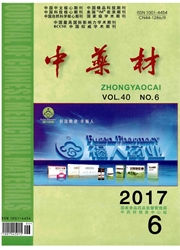

 中文摘要:
中文摘要:
目的:研究加拿大原产地1-5年生5-9月采收西洋参根中人参皂苷Rg1、Re、Rb1、Rg2、Rc、Rb2、Rb3、Rd、Rg3和拟人参皂苷F11、RT5的含量动态变化。方法:采用RP-HPLC-ELSD法。Dimaonsil C18柱(250 mm×4.6mm,5μm),柱温30℃,流动相为乙腈(A)-水(B),流速1.0 m L/min,进样量为10μL,ELSD载气为氮气,气体流量为2.8 L/min,漂移管温度为100℃。采用SPSS 19.0统计软件对试验结果进行主成分和系统聚类分析。结果:建立了同时测定西洋参根中9种人参皂苷和2种拟人参皂苷类成分含量的RP-HPLC-ELSD方法。人参皂苷积累表明,1、2年生含量低,5-9月呈增加趋势;3-5年生样品,6、7月呈下降趋势,随后缓慢增加,9月均达到最大积累;从3年生9月开始样品的含量接近;除人参皂苷Rc的含量较低和部分样品中未检测到外,其他组分含量均很高,其中以人参皂苷Rd、Rb3和拟人参皂苷F11的含量最高。主成分分析表明,人参皂苷Rg1、Re、Rb1、Rc、Rb2、Rb3、Rg3和拟人参皂苷F11、RT5为加拿大西洋参的特征皂苷成分。系统聚类分析表明,除4年生7月(S18)样品外,1年生和2年生的西洋参根样品在皂苷组成和含量变化上接近;3-5年生各月的皂苷组成和含量变化没有明显的界限划分。结论:基于人参皂苷含量、西洋参栽培第4-5年的栽培种植成本、遭受涝害和病虫害的风险,建议从3年生9月开始,西洋参根可以视为同等质量。
 英文摘要:
英文摘要:
Objective: To research the dynamic accumulation of ginsenosides Rg1,Re,Rb1,Rg2,Rc,Rb2,Rb3,Rd,Rg3 and pseudo-ginsenosides F11,RT5,which was grown from one-to five-year-old and harvested from May to September of Panax quinquefolium root in Canada. Methods: RP-HPLC-ELSD was adopted. The analysis was performed on a Dimaonsil C18(250 mm × 4. 6 mm,5 μm) column,the mobile phase was acetonitrile(A)-deionized water(B) in gradient elution mode. The flow rate was 1. 0 m L/min and column temperature was set at 30 ℃. The carrier gas was nitrogen with flow rate of 2. 8 L/min,the drift tube temperature was 100 ℃,and the injection volume was 10 μL. The principle component analysis and cluster analysis of SPSS software(version 19. 0) were conducted for the data analysis. Results: The RP-HPLC-ELSD method for determining simultaneously nine ginsenosides and two pseudo-ginsenosides was established. The total content of ginsenosides of one- to two-year-old was low and increased from May to September in each year. That of three- to five-year-old declined from June to July and increased from August,and was the highest in September of three- to five-year-old samples. The total content from September of three-year-old samples was similar. The content of nine ginsenosides and two pseudo-ginsenosides was relatively high in all the samples except ginsenoside Rc,which wasn't determined in some samples. The ginsenosides Rd,Rb3 and pseudo-ginsenoside F11 were higher than others. The principle component analysis results showed that ginsenosides Rg1,Re,Rb1,Rc,Rb2,Rb3,Rg3 and pseudo-ginsenosides F11,RT5 could be the characteristic ginsenosides of Panax quinquefolium root in Canada. The cluster analysis indicated that the chemical constituent and dynamic accumulation of ginsenosides of one- to two-year-old was similar except the sample of July of four-year-old and there was no obvious difference of three- to five-year-old. Conclusion: With the consideration of the content of ginsenoside,cultivation cost of four-to
 同期刊论文项目
同期刊论文项目
 同项目期刊论文
同项目期刊论文
 Application of Morphoanatomy and Microscopy in Authentication of Three Species of Traditional Chines
Application of Morphoanatomy and Microscopy in Authentication of Three Species of Traditional Chines Fingerprints analysis of the Chemical Components of Petroleum Ether Parts of Renqing Mangjue and Ren
Fingerprints analysis of the Chemical Components of Petroleum Ether Parts of Renqing Mangjue and Ren Comparison of the Content Changes of Strychnine and Brucine in Renqingmangjue Combined with or witho
Comparison of the Content Changes of Strychnine and Brucine in Renqingmangjue Combined with or witho Evaluation of Essential and Toxic Element Concentrations in Buckwheat by Experimental and Chemometri
Evaluation of Essential and Toxic Element Concentrations in Buckwheat by Experimental and Chemometri 期刊信息
期刊信息
